
views
Consuming a Simple Diet
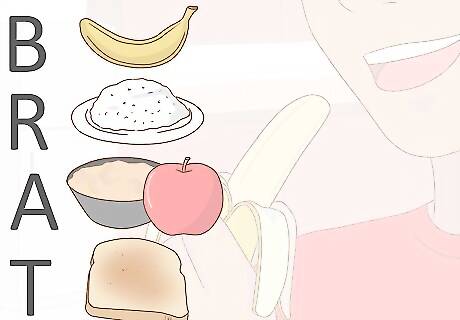
Follow the BRAT diet. Some doctors suggest the BRAT diet, which stands for Bananas, Rice, Applesauce, and Toast. These foods can help you recover from nausea and vomiting because the foods are low in fiber and easy to digest and help replace nutrients lost. The American Academy of Pediatrics (AAFP) no longer recommends the BRAT diet for children. Instead, the AAFP recommends that children resume eating a normal, well-balanced, age appropriate diet within 24 hours of getting sick. Some other foods that are easy to digest: Crackers: saltines, oyster crackers, rice crackers or other "white flour" crackers. Boiled potatoes Noodles/Pasta: plain egg noodles, pasta, or ramen noodles. Avoid whole wheat. Gelatin: often referred by brand names such as "Jello" although any will do. The choice of flavoring is yours.
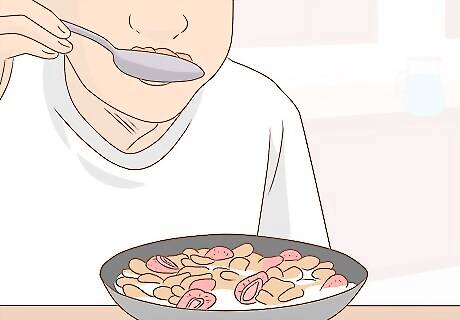
Add more complex foods gradually. Once you are able to keep down very simple foods such as broth, rice, bananas, and toast, add more complex foods as you feel better. This can help minimize nausea and vomiting and will not strain your stomach. Examples of more complex foods you can try as you feel better are cereal, fruit, cooked vegetables, chicken, creamy peanut butter, and white pasta without sauce.
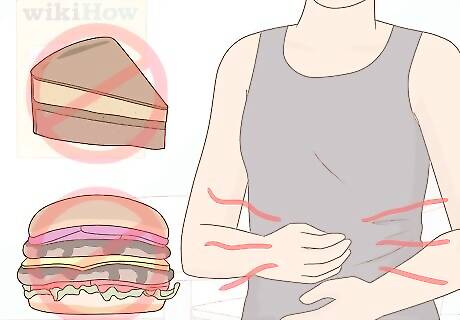
Avoid foods that can upset your stomach. It’s important to be gentle on your stomach at this time. Avoiding foods such as dairy or spicy dishes can help prevent further vomiting. Avoid fatty foods, including fried dishes. For example, if you have been vomiting, a greasy cheeseburger is likely to exacerbate your nausea and may make you throw up more. Stay away from spicy foods such as curries, chili, Buffalo wings or barbeque. Dairy products including milk, yogurt, and cheese may make you more nauseous or vomit. Sugary foods such as cookies and cakes may trigger nausea or cause more vomiting. Stay away from whole grain breads, cereals, or pastas until your nausea has passed. Nuts and seeds may also upset your stomach.
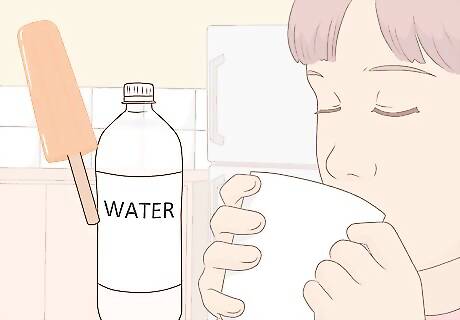
Drink plenty of clear liquids. Stay hydrated when you have been vomiting or sick. Drinking plenty of clear liquids may help you stay hydrated and also soothe your stomach and relive nausea. Liquids are more important than solids. Your body will suffer from dehydration long before issues from fasting become problematic. Many foods contain a lot of liquid, such as gelatin, bananas, or rice. You can drink any beverage that is clear or turns into a clear liquid when at room temperature, such as an ice cube, soup, ginger ale, or ice pop. Water, fruit juices without pulp, soup broths, clear sodas such as ginger ale or Sprite, teas, and popsicles may help you stay hydrated and keep you from vomiting. Electrolyte or sports drinks can help replace some nutrients and also settle your stomach. However, do not use full strength. Either dilute by at least half, or for every sip of energy drink, take a drink of water. Sports drinks are typically far too concentrated, and diluting them is easier on the stomach.
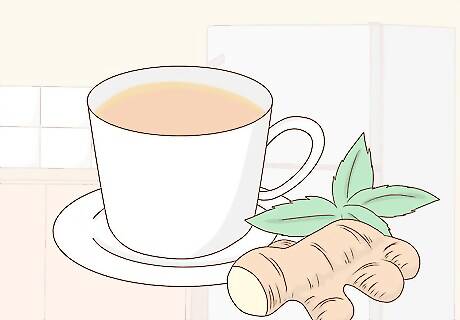
Brew ginger tea or peppermint tea. There is some medical evidence that ginger and peppermint teas may help nausea and vomiting. Brew yourself either ginger or peppermint teas to help soothe and settle your stomach and stay hydrated. You can make these by either using commercial ginger or peppermint tea bags or using a few mint leaves or a piece of ginger steeped in boiling water.
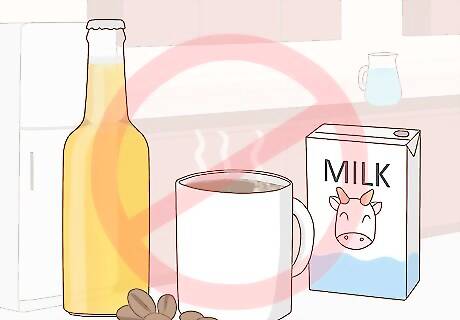
Stay away from liquids that can cause nausea or vomiting. Avoid drinking anything that is hard on the stomach. Consuming liquids such as alcohol, coffee, or milk can make nausea worse and may make you vomit. Do not put cream in any tea you drink.
Eating and Drinking When Vomiting
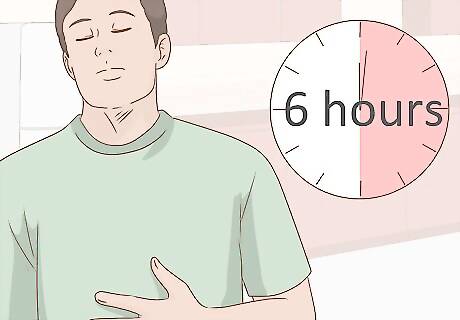
Wait to eat until you have stopped vomiting. It seems common sense, but unfortunately sometimes people will rush to eat foods before the stomach is ready. If you are actively vomiting, wait to eat solid foods until you can consume them without throwing up. Instead, drink clear liquids or electrolyte beverages to help keep you from becoming dehydrated. Eat solid foods only after you haven’t vomited for about six hours.
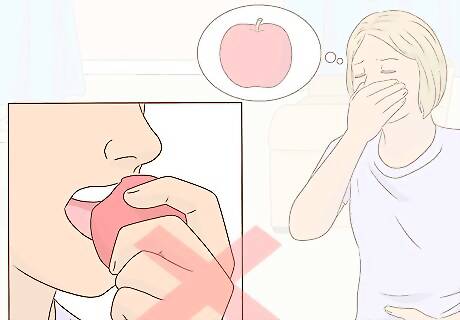
If your stomach turns queasy when you see or envision a food, do not eat it. The body is sometimes wiser than the head. Also, if you feel nauseated just thinking about a certain food, chances are good you will not keep it down. There is a mental element to how your body processes nausea, and it is very difficult to overcome. If your stomach churns at the thought of eating a banana, but seems fine with a small bowl of rice, eat the rice.

Eat foods that are easy to digest. Certain foods, including dairy, can exacerbate nausea and vomiting. Eating foods that are easy to digest may help you keep them down and alleviate vomiting. Once you’re able, try solid foods on the BRAT diet and other simple options such as boiled potatoes and clear soups. You can add more complex foods as you feel better.
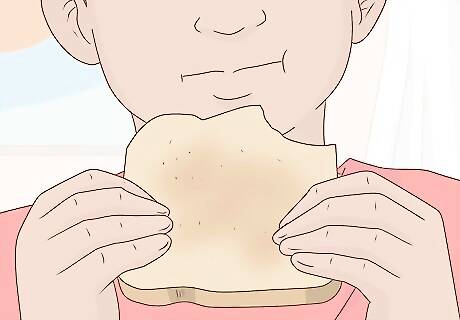
Eat small meals and chew your food thoroughly. While you are eating a simple, bland diet, eat small meals throughout the day and make sure that you chew your food slowly and thoroughly. This may help minimize nausea and help you keep food down. Start out with a piece of toast or a banana. Add other simple foods as you are able. For example, if you are able to keep a piece a toast down and are still hungry, have a banana a half an hour or an hour later. Chewing your food thoroughly will help keep your stomach from having to do extra work digesting. Taking small bites will help you chew more thoroughly. This method will also help you see if you are able to tolerate food more easily than if you overwhelm your stomach by overloading it.
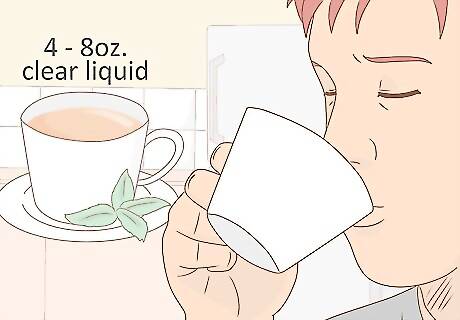
Take small sips of liquid. Just as it’s important to take small bites, it’s also helpful to take small sips of liquid. This may help not overwhelm your stomach and cause further nausea. Sip 4-8oz. of clear liquid every hour and only 1-2 ounces at a time. This will help keep you hydrated without increasing your risk for further vomiting or hyponatremia, which is having too little sodium in your body. If you can’t tolerate sips of liquid, try sucking on ice chips until you can safely consume 1-2oz. of liquid at a time.
Using Alternative Options to Relieve Nausea and Vomiting

Be aware of what medications that can upset your stomach. Certain medications, such as oxycodone, can upset your stomach and cause nausea. If you are taking any medications that unsettle the stomach, speak to your doctor about discontinuing their use until you feel better. Pain medications such as codeine, hydrocodone, morphine, or oxycodone can cause nausea. Some over the counter medications such as iron or potassium supplements, and even aspirin, can cause nausea.
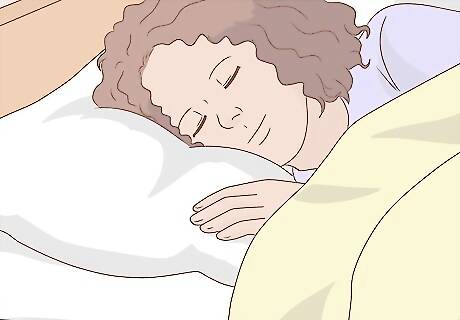
Get sufficient rest. In many cases, simply resting can help relieve nausea and vomiting. Lie down as often as you can, especially after eating, to help you keep food down. Getting too much activity can make nausea and vomiting worse by unsettling your stomach.
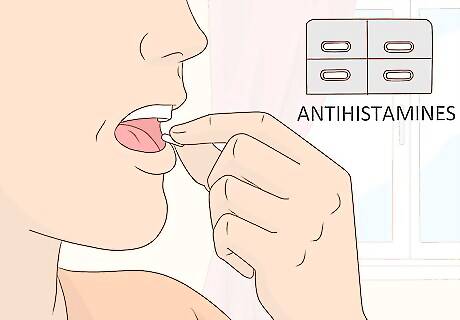
Try motion sickness medications and antihistamines. If you are unable to keep anything down because of motion sickness, consider taking a medication or antihistamine. These may help alleviate the nausea and vomiting and allow you to eat something. You can try over the counter antihistamines such as dimenhydrinate to help keep food down. Follow either your doctor’s instructions or the directions on the packaging. If you’re experiencing severe nausea and vomiting, your doctor can prescribe scopolamine, which comes as an adhesive patch. Scopolamine can only be used by adults. Alleviate nausea with pressure points. This really works, and requires no medication or any great expertise in Eastern style medicine.

See your doctor. If you experience nausea, vomiting, or the inability to keep food or liquids down for a protracted period of time, see your doctor. She will help rule out more serious conditions and can develop a course of treatment to help you keep down foods. If you have been vomiting for longer than 24 hours, see your doctor as soon as possible. If you haven’t kept any fluids down for 12 or more hours, seek medical treatment. If you have blood or dark material in your vomit, go to the emergency room. If you have severe vomiting—you vomit more than three times per day—see a medical professional.



















Comments
0 comment